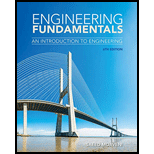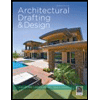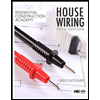
ENGINEERING FUNDAMENTALS
6th Edition
ISBN: 9781337705011
Author: MOAVENI
Publisher: CENGAGE L
expand_more
expand_more
format_list_bulleted
Question
Chapter 16, Problem 13P
To determine
Draw the top, the front and the right side orthogonal views of the given object and indicate when an object needs only one or two views.
Expert Solution & Answer
Trending nowThis is a popular solution!

Students have asked these similar questions
B2. For the truss below, determine all member forces. Hint: see the provided slide with the
problem set. P₁ = 12 kip and P2 = 6 kip (20 pts).
P₁
A
16 ft
D
8 ft
8 ft
8 ft
B
J
K
E
8 ft
8 ft
I
H
G
8 ft
8 ft
8 ft
B₁₂
F
ΠΟΙΟΣ
Directions: Show your solutions explicitly, I.e., do not just write the final answer. Always simplify and box your final
answer.
1. A wall footing is to be constructed on a clay soll 1.4 below the ground. The footing is to support a wall that
imposes a load of 130 kN per meter of wall length. Considering general shear failure, determine the following:
130 kN/m
4m
a. Footing width if the factor of safety is 3.
b. Ultimate bearing capacity if B = 0.95 m.
c. New factor of safety.
Y = 17.92 kN/m²
c = 14.5 kPa
$ -30°
2. A square footing shown has a dimension of 1.5 mx 1.5 m and has its bottom 2 m below the ground surface.
The groundwater table is located at a depth of 3 m below the ground surface. Assume a general shear failure.
Determine the following:
L
2 m
y = 16 kN/m³
c = 14.5 kPa
= 28°
3 m
1.5 m
Ysa1 = 18.5 kN/m³
a. Ultimate bearing capacity of the soll beneath the footing (in kPa).
b. Allowable bearing capacity if it has a factor of safety of 3 (in kPa).
C. Allowable load that the…
B2. For the truss below, determine all member forces. Hint: see the provided slide with the
problem set. P₁ = 12 kip and P₂ = 6 kip (20 pts).
P₁
16 ft
D
8 ft
8 ft
8 ft
B
K
E
8 ft
8 ft
8 ft
H
8 ft
В
G
1000
8 ft
Chapter 16 Solutions
ENGINEERING FUNDAMENTALS
Ch. 16.1 - Prob. 1BYGCh. 16.1 - Prob. 2BYGCh. 16.1 - Prob. 3BYGCh. 16.1 - Prob. 4BYGCh. 16.1 - Prob. BYGVCh. 16.3 - Prob. 1BYGCh. 16.3 - Prob. 2BYGCh. 16.3 - Prob. 3BYGCh. 16.3 - Prob. 4BYGCh. 16.3 - Prob. 5BYG
Ch. 16.3 - Prob. BYGVCh. 16.4 - Prob. 1BYGCh. 16.4 - Prob. 2BYGCh. 16.4 - Give examples of common electrical engineering...Ch. 16.4 - Prob. 4BYGCh. 16.4 - VocabularyState the meaning of the following...Ch. 16 - Prob. 1PCh. 16 - Prob. 2PCh. 16 - Prob. 3PCh. 16 - Prob. 4PCh. 16 - Prob. 5PCh. 16 - Prob. 6PCh. 16 - Prob. 7PCh. 16 - Prob. 8PCh. 16 - Prob. 9PCh. 16 - Prob. 10PCh. 16 - Prob. 11PCh. 16 - Prob. 12PCh. 16 - Prob. 13PCh. 16 - Prob. 14PCh. 16 - Prob. 15PCh. 16 - Prob. 16PCh. 16 - Prob. 17PCh. 16 - Prob. 18PCh. 16 - Prob. 19PCh. 16 - Prob. 20PCh. 16 - Prob. 21PCh. 16 - Prob. 22PCh. 16 - Prob. 23PCh. 16 - Prob. 24PCh. 16 - Prob. 25PCh. 16 - Prob. 26PCh. 16 - Prob. 27PCh. 16 - Prob. 28PCh. 16 - Prob. 29PCh. 16 - Prob. 30PCh. 16 - Prob. 31PCh. 16 - Prob. 32PCh. 16 - Prob. 33PCh. 16 - Prob. 34PCh. 16 - Prob. 35PCh. 16 - Prob. 36PCh. 16 - Prob. 37PCh. 16 - Prob. 38PCh. 16 - Prob. 39PCh. 16 - Prob. 40PCh. 16 - Prob. 41PCh. 16 - Prob. 42PCh. 16 - Prob. 43PCh. 16 - Prob. 44PCh. 16 - Prob. 45PCh. 16 - Prob. 46PCh. 16 - Prob. 47PCh. 16 - Prob. 48PCh. 16 - Prob. 49PCh. 16 - Prob. 50P
Knowledge Booster
Similar questions
- 14.1 A beam of rectangular cross section is 125 mm wide and 200 mm deep. If the maximum bending moment is 28.5 kN⚫m, determine (a) the maximum tensile and compressive bending stress, and (b) the bending stress 25 mm from the top of the section. 14.2 A rectangular beam 50 mm wide and 100 mm deep is subjected to bending. What bending moment will cause a maximum bending stress of 137.9 MN/m² (MPa)? 14.3 Determine the bending moment in a rectangular beam 3 in. wide and 6 in. deep if the maximum bend- ing stress is 15,000 psi.arrow_forwardB3. For the Howe truss below, assume all members are pin connected and take P₁ = 5 kN and P₂ = 10 kN: a. Determine all member forces (16 pts). b. Use a section cut to verify your answers for members GF, GD, and CD (4 Pts) P₁ A H 500 8 0000 B 0000] 2 m m 2 m 3 m B E D marrow_forwardI need detailed help solving this exercise from homework of Engineering Mathematics II.I do not really understand how to do, please do it step by step, not that long but clear. Thank you!P.S.: Please do not use AI, thanks!arrow_forward
- I need detailed help solving this exercise from homework of Engineering Mathematics II.I do not really understand how to do, please do it step by step, not that long but clear. Thank you!P.S.: Please do not use AI, thanks!arrow_forwardI need detailed help solving this exercise from homework of Engineering Mathematics II.I do not really understand how to do, please do it step by step, not that long but clear. Thank you!P.S.: Please do not use AI, thanks!arrow_forwardI need detailed help solving this exercise from homework of Engineering Mathematics II.I do not really understand how to do, please do it step by step, not that long but clear. Thank you!P.S.: Please do not use AI, thanks!arrow_forward
- I need detailed help solving this exercise from homework of Engineering Mathematics II.I do not really understand how to do, please do it step by step, not that long but clear. Thank you!P.S.: Please do not use AI, thanks!arrow_forwardI need detailed help solving this exercise from homework of Engineering Mathematics II.I do not really understand how to do, please do it step by step, not that long but clear. Thank you!P.S.: Please do not use AI, thanks!arrow_forwardI need detailed help solving this exercise from homework of Engineering Mathematics II.I do not really understand how to do, please do it step by step, not that long but clear. Thank you!P.S.: Please do not use AI, thanks!arrow_forward
- I need detailed help solving this exercise from homework of Engineering Mathematics II.I do not really understand how to do, please do it step by step, not that long but clear. Thank you!P.S.: Please do not use AI, thanks!arrow_forwardB1.For the truss below, take P₁ = 4 kip and P₂ = 3 kip: a. Determine all member forces. Hint: first find zero-force members (16 pts). b. Use a section cut to verify your answers for members JI, BI, and BC (4 Pts) В 18 ft 6 ft H B 6 ft C 8 ft D p81 8 ft E 8 ft 6 ft F6ftarrow_forwardQ13: The line CD, C(xc, 6), D(6,yd), the point D is on the right of point C, the value of horizontal effect H(3,0) is on the right of point C, the vertical effect V(0, -2) right of H. the distance between projection of the points H, V is 5cm, Find: 1- The value of xc and yd. 2- The distance between projections of the points C, D. 3- The true length (T.L.) of CD. 4- The angles a and ẞ. 5- A point F in the middle of line CD, find F (xf, yf).arrow_forward
arrow_back_ios
SEE MORE QUESTIONS
arrow_forward_ios
Recommended textbooks for you
 Engineering Fundamentals: An Introduction to Engi...Civil EngineeringISBN:9781305084766Author:Saeed MoaveniPublisher:Cengage Learning
Engineering Fundamentals: An Introduction to Engi...Civil EngineeringISBN:9781305084766Author:Saeed MoaveniPublisher:Cengage Learning Architectural Drafting and Design (MindTap Course...Civil EngineeringISBN:9781285165738Author:Alan Jefferis, David A. Madsen, David P. MadsenPublisher:Cengage Learning
Architectural Drafting and Design (MindTap Course...Civil EngineeringISBN:9781285165738Author:Alan Jefferis, David A. Madsen, David P. MadsenPublisher:Cengage Learning Residential Construction Academy: House Wiring (M...Civil EngineeringISBN:9781337402415Author:Gregory W FletcherPublisher:Cengage Learning
Residential Construction Academy: House Wiring (M...Civil EngineeringISBN:9781337402415Author:Gregory W FletcherPublisher:Cengage Learning

Engineering Fundamentals: An Introduction to Engi...
Civil Engineering
ISBN:9781305084766
Author:Saeed Moaveni
Publisher:Cengage Learning

Architectural Drafting and Design (MindTap Course...
Civil Engineering
ISBN:9781285165738
Author:Alan Jefferis, David A. Madsen, David P. Madsen
Publisher:Cengage Learning

Residential Construction Academy: House Wiring (M...
Civil Engineering
ISBN:9781337402415
Author:Gregory W Fletcher
Publisher:Cengage Learning